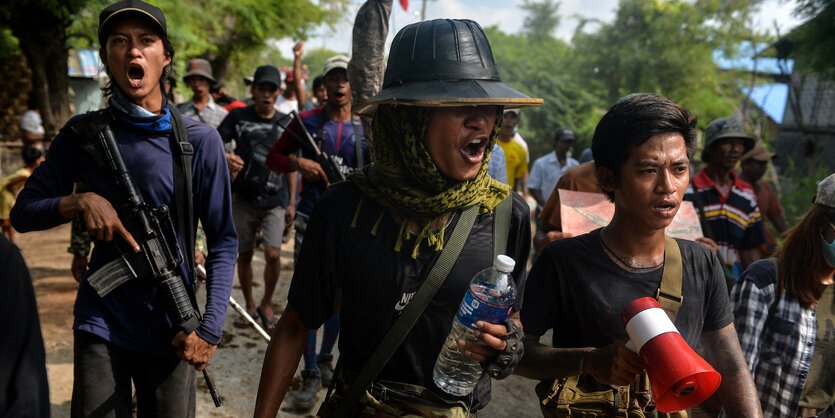Myanmar’s civil war, which erupted following the military coup of February 2021, has entered its most violent and consequential phase. The country, long plagued by ethnic conflicts, is now experiencing nationwide resistance and an unprecedented uprising against military rule. Recent escalations in 2024 have intensified humanitarian crises and raised alarms for regional stability. This article examines the evolution of the conflict, the latest developments, and the potential consequences for Southeast Asia.
On February 1, 2021, Myanmar’s military (the Tatmadaw) deposed the democratically elected government of Aung San Suu Kyi’s National League for Democracy (NLD), alleging electoral fraud. This triggered mass protests and a nationwide Civil Disobedience Movement (CDM). The military responded with lethal force, killing and imprisoning thousands of civilians.
Ethnic armed organizations (EAOs), already at odds with the central government, saw the coup as an opportunity to intensify their long-standing struggles. The People’s Defense Forces (PDFs)—armed groups comprising civilians, students, and defecting soldiers—emerged across the country. Together, they formed the anti-junta National Unity Government (NUG), a parallel administration seeking international recognition.
The Escalating Conflict
After initial peaceful protests were brutally suppressed, resistance shifted to armed conflict. The PDFs, with support from some EAOs, launched attacks on military convoys, police stations, and government offices. The Tatmadaw responded with indiscriminate airstrikes and scorched-earth tactics, especially in ethnic minority regions like Chin, Karen, Kachin, and Kayah states.
By late 2023, anti-junta forces achieved a new level of coordination. The Three Brotherhood Alliance (comprising the Arakan Army, Myanmar National Democratic Alliance Army, and Ta’ang National Liberation Army) launched Operation 1027 in northern Shan State, capturing key towns and border crossings. This operation disrupted critical trade routes with China and inflicted significant losses on the Tatmadaw.
Meanwhile, the NUG and allied EAOs intensified attacks in Sagaing and Magway regions, traditionally Bamar strongholds, stretching the military’s resources thin. Myanmar’s military, facing desertions and manpower shortages, increasingly relied on heavy artillery and airstrikes, often targeting civilian areas.
In early 2024, opposition forces made remarkable territorial gains, especially in the north and east. The Arakan Army seized significant parts of Rakhine State, and urban guerrilla attacks in Yangon and Mandalay became more frequent. Reports surfaced of entire battalions surrendering to resistance groups. The military government’s control shrank to urban centers and key military bases, while large swathes of rural Myanmar fell under opposition or EAO rule. This has continued into late 2025, however, recent junta strikes have done immense damage.
The conflict has displaced nearly 3 million people by mid-2024, according to the UN. Humanitarian access remains severely restricted. Food shortages, destroyed infrastructure, and targeted reprisals against civilians have led to dire conditions, especially in contested regions. Aid organizations have warned of looming famine in some areas.
Regional and International Dimensions
The intensification of Myanmar’s civil war since 2021 has created ripples that extend far beyond its borders, deeply affecting the Southeast Asian region and even drawing the attention of global powers. As the conflict has escalated in 2024, neighboring countries have grown increasingly anxious about the direct and indirect consequences of prolonged instability in Myanmar.
One of the most immediate and visible regional impacts has been the surge in refugees and displaced persons seeking safety across borders. Thailand, which shares a long and porous border with Myanmar, has seen repeated waves of refugees fleeing the fighting, especially from Karen and Kayah states. Makeshift camps have sprung up along the Thai-Myanmar frontier, placing pressure on the Thai government to provide humanitarian assistance while also managing security risks. Bangladesh, already struggling with the Rohingya refugee crisis, faces the threat of further arrivals from Rakhine State, where renewed fighting between the military and the Arakan Army has devastated local communities. The presence of large refugee populations creates strains on resources, raises public health concerns, and can become a source of tension between host communities and newcomers.
Beyond the humanitarian dimension, the civil war has serious security implications for the region. The proliferation of weapons and the breakdown of central authority in some parts of Myanmar have facilitated cross-border crime, including drug trafficking and human smuggling. Armed groups operating in lawless border areas have sometimes clashed with security forces from neighboring countries. There is a growing fear that transnational insurgent or extremist networks could exploit the chaos, further destabilizing borderlands and potentially drawing Myanmar’s neighbors deeper into the conflict. This is particularly concerning for India and China, both of which have significant strategic and economic interests in the region and have faced security challenges in their own border areas adjacent to Myanmar.
Economic disruptions are another major concern. Myanmar’s position as a conduit for regional trade means that instability within its borders can have ripple effects throughout Southeast Asia. The fighting has disrupted vital cross-border trade routes, especially those linking Myanmar to China. Key infrastructure projects, many part of China’s Belt and Road Initiative, have been delayed or endangered by the conflict, threatening billions of dollars in investment and undermining Beijing’s ambitions for regional connectivity. Thailand and other ASEAN states have suffered interruptions in the flow of goods and resources, impacting local economies and complicating post-pandemic recovery efforts.
On a geopolitical level, the Myanmar crisis has become a litmus test for the effectiveness of ASEAN as a regional organization. ASEAN’s inability to enforce its Five-Point Consensus or broker meaningful dialogue has exposed its limitations in dealing with internal conflicts among member states. The junta’s refusal to engage constructively with ASEAN has forced the bloc to take the unusual step of sidelining Myanmar’s military leaders from high-level meetings. Nevertheless, ASEAN remains divided, with member states like Thailand and Vietnam reluctant to take a harder line, while others, such as Indonesia and Malaysia, push for a more principled stance. This division weakens ASEAN’s credibility and undermines its centrality in managing regional security issues.
Meanwhile, the conflict has become entangled in broader great power competition. China’s pragmatic approach—maintaining ties with both the junta and various ethnic armed groups—reflects its desire to secure its investments and prevent instability from spilling into Yunnan Province. At the same time, China is wary of being seen as propping up an unpopular regime, especially as anti-China sentiment grows among Myanmar’s resistance forces. The United States and European Union, for their part, have imposed sanctions and supported the pro-democracy movement, but their influence is limited by geography and the complex realities on the ground. Russia’s open support for the junta, through arms sales and diplomatic backing, adds another layer to the geopolitical chessboard. Myanmar, thus, risks becoming an arena of proxy competition, complicating efforts to achieve a peaceful resolution.
Looking ahead, the fate of Myanmar will have far-reaching implications for regional stability. A prolonged civil war risks entrenching the country as a source of chronic instability, with persistent humanitarian, security, and economic spillovers. Conversely, a negotiated settlement or a transition to more inclusive governance could serve as a positive example for conflict resolution in other parts of Southeast Asia. Ultimately, the region’s ability to respond collectively and constructively to Myanmar’s crisis will not only shape the country’s own future, but will also test the resilience and relevance of Southeast Asian cooperation in an era of heightened uncertainty.





















